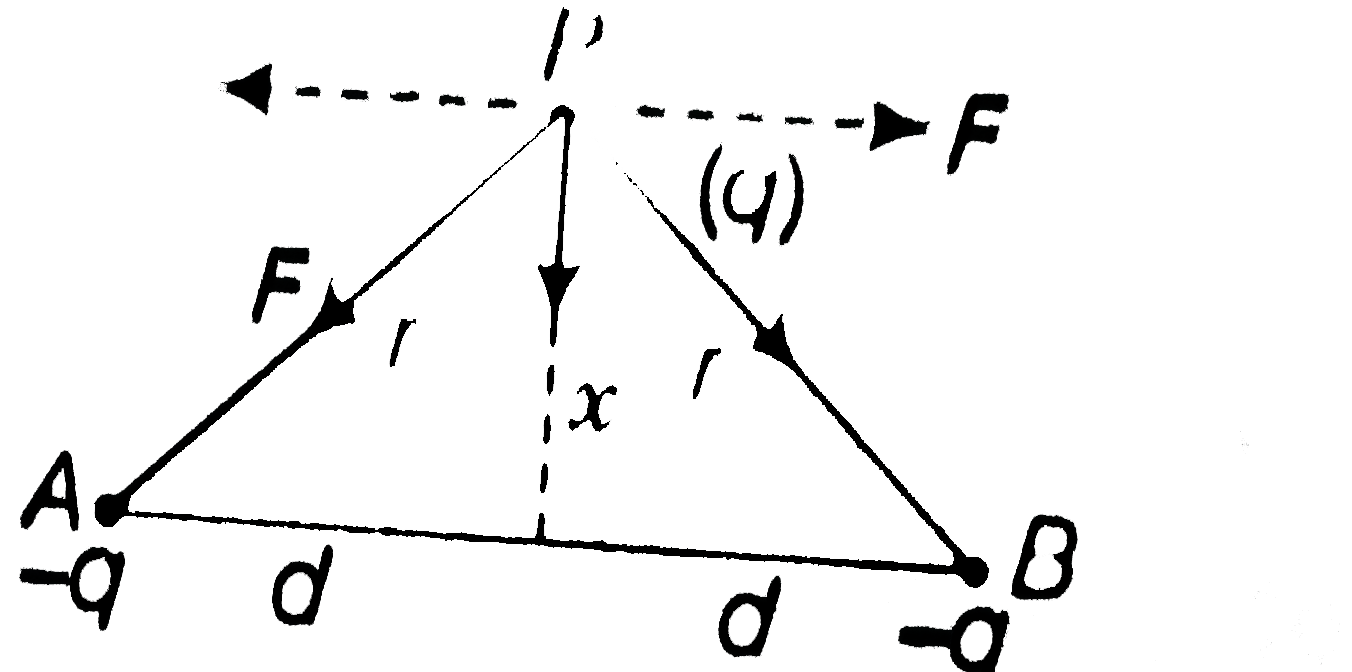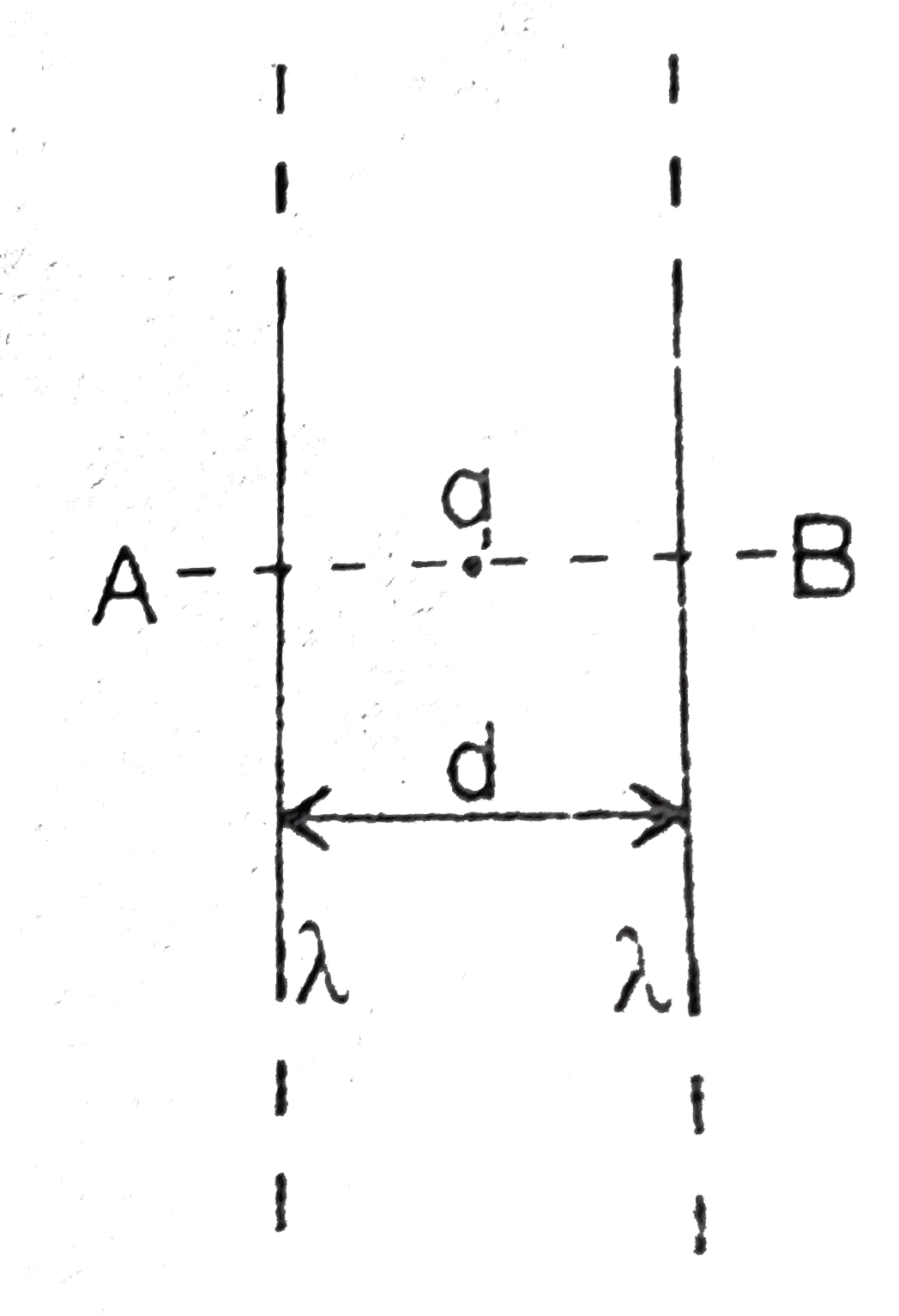Two charges −q each are fixed separated by distance 2d. A third charge q of mass m placed at the mid-point is displaced slightly by x(x<<d) perpendicular to the line joining the two fixed charges as shown in Fig. Show that q will perform simple harmonic oscillation of time period.
T=[8π3∈0md3q2]1/2
![Two charges -q each are fixed separated by distance 2d. A third charge q of mass m placed at the mid-point is displaced slightly by x (xltltd) perpendicular to the line joining the two fixed charges as shown in Fig. Show that q will perform simple harmonic oscillation of time period. T = [(8pi^(3) in(0) md^(3))/(q^(2))]^(1//2)](https://d10lpgp6xz60nq.cloudfront.net/physics_images/PR_XII_V01_C01_S01_623_Q01.png)
Let us elaborate the figure first.
given two charge -q at A and B
AB=AO+OB=2d
x=small distance perpendicular to O.
i.e., xltd mass of charge q is So, force attraction at P towards A and B are each F=q(q)4πε0r2, where AP=BP=r
Horizontal components of these forces Fn are cancel out. Vertical components along PO add.
If ∠APO=O, the net force on q along PO is F'=2FcosQ ltBrgt =2q24πε0r2(xr)
=2q2x4πε0(d2+x2)3/2
When, x<<d,F'=2q2x4πε0d3=kX
Where, K=2q24πε0d3
I.e., force on charge q is proportional to its displacement from the centre O and it is directed towards O.
Hence, motion of charge q would be simple harmonic, where
ω=√Km
and T=2πω=2π√mK
=2π√m.4πε0d32q2=[8π3ε0md3q2]1/2

Topper's Solved these Questions
- ELECTRIC CHARGES AND FIELDBOOK - NCERT EXEMPLAR ENGLISHCHAPTER - ELECTRIC CHARGES AND FIELDEXERCISE - Short Answer Type question
6 Videos
- DUAL NATURE OF RADIATION AND MATTERBOOK - NCERT EXEMPLAR ENGLISHCHAPTER - DUAL NATURE OF RADIATION AND MATTEREXERCISE - LONG ANSWER TYPE QUESTION
5 Videos
- ELECTROMAGNETIC INDUCTION BOOK - NCERT EXEMPLAR ENGLISHCHAPTER - ELECTROMAGNETIC INDUCTION EXERCISE - Long
11 Videos
Similar Questions
Two equal charges q are placed at a distance of 2a and a third charge −2q is placed at the midpoint. The potential energy of the system is
View SolutionTwo charges q and -3q are placed fixed on x-axis separated by distance d. where should a third charge 2q be placed such that it will not experience any force?
View SolutionTwo charges q and −3q are placed fixed on x-axis separated by distance d. Where should a third charge 2q be placed such that it will not experience any force ?
View SolutionTwo charges −q each are separated by distance 2d. A third charge +q is kept at mid-point O. Find potential energy of +q as a function of small distance x from O due to −q charges. Prove that the charge at O is in an unstable equilibrium.
View SolutionTwo point charges q each are fixed at (a,0) and (-a,0). A third charge Q is placed at origin. Electrons potential energy of the system will
View SolutionTwo point charges +q and −q are placed a distance x apart. A third charge is so placed that at the three charges are in equilibrium. Then
View SolutionTwo point charges q and −q are separated by a distance 2l. Find the flux strength vector across the circle of radius R placed with its centre coinciding with the of line joining the two charges in the perpendicular plane.
View SolutionTwo infinitely long line charges having charge density λ each are parallel to each other and separated by distance d. A charge particle of mass m and charge q is placed at mid point between them. This charge displaced slightly along a line AB which is perpendicular to the line charges and in the plane of the charges. prove that the motion of the particle will be SHM for small displacement and λq>0 Neglect gravity. Find the time period.

View SolutionA charge Q is placed at the centre of the line joining two point charges +q and +q as shown in figure. The ratio of charges Q and q is

View SolutionTwo points charges +4q and +q are separated by distance r, where should a third point charge Q be placed that the whole system remains in equilibrium
View Solution
